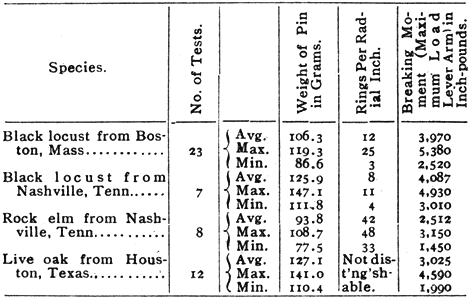[Trade Journal]
Publication: Western Electrician
Chicago, IL, United States
vol. 40, no. 5, p. 110, col. 1
Strength of Elm, Oak and Locust
Insulator Pins.
At the request of certain consumers the Forest Service of the United States Department of Agriculture recently made tests on 53 insulator pins of rock elm, live oak and black locust. The tests were made at the timber-testing station of the Forest Service at Purdue University, Lafayette, Ind. The results indicate the relative strength of the pins tested. They depend upon too small a number of tests, however, to show in an authoritative way the relative value of these woods.
The pins were of standard size, 1 1/4 inches by 8 inches. The oak pins were from one-eighth to one-quarter inch shorter than the others, and of slightly smaller diameter at the shoulder. Their lever arm was also about one-half inch shorter than in the cases of the other two species.
In testing the pins an iron block was clamped to the fixed upper head of a small screw-testing machine. The pins were inserted to a tight fit in a hole in this iron block, and projected horizontally over the pulling head of the machine. The glass insulator was unable to bear the strain of the wire, so an iron model of the ordinary glass insulator was screwed on the pin and connected by means of a heavy wire to the pulling head of the machine. When a strain was put on this wire the pin acted as a beam fixed at one end and loaded at the other, which is practically the condition met with in practice. The breaking moment (maximum load times lever arm) is taken as a measure of the strength of the pins. The iron block mentioned was used in preference to a wooden cross-arm for supporting the pins for the reason that this iron block forced the pins to break under the test. Furthermore, it furnished uniform conditions for all pins. Thus, the results of the tests do not show the strength of a combination of pins and cross-arm, but they show the bending strength of the pin itself.
The following table gives the results of the tests:
 |
From the table it appears that the breaking strength of the two shipments of black-locust pins was practically the same, and may be taken as 4,000 pounds. Live-oak pins came next in order of strength, with a breaking moment of about 3,000 pounds. Rock-elm pins were the weakest, having a breaking strength of 2,500 pounds.
The oak pins were the heaviest, the locust next, and the elm the lightest.
The locust and elm pins failed mostly by splitting from the threads to the shoulder, or by tension at the shoulder. Occasionally the portion of the pin inserted in the block failed by shearing horizontally. The oak pins nearly all failed by tension at the shoulder.
